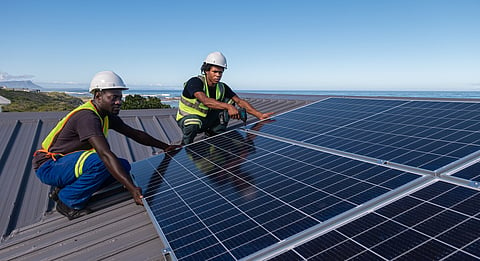

Solar panel imports into Africa rose by a record 60 per cent in the 12 months to June 2025 according to a new analysis of China’s solar panel exports, indicating a steady demand for clean energy in the world's least connected region.
The data by international energy think tank Ember, show that solar panels with capacity to generate an equivalent of 15,032 MWs of power were imported into the continent, much higher than the 9,379 MWs equivalent in solar panels in the preceding 12 months.
The rise, according to the analysis, happened across Africa in 20 countries, with 25 countries setting a new record by importing at least 100 MWs in capacity each. This was up from 15 countries that shipped in the capacity in panels the previous year, in what could potentially point to a solar energy take-off on the continent.
Some countries recorded “very high” growth rates with Algeria’s imports rising 33-fold, Zambia eightfold, Botswana seven times, and Sudan six-fold, while Liberia, Democratic Republic of Congo, Benin, Angola and Ethiopia all more than tripled their imports, the report notes.
In some of the countries with the lowest access to electricity, the panels brought in exceeded or were half the amount of power generated in 2023, the last time when imports surged.
“The last time imports surged was in 2023, when South Africa solar imports picked up as the power crisis hit its peak. However, this time is different — much of the pick-up in the last 12 months happened outside of South Africa,” the report titled The first evidence of a take-off in solar in Africa, dated August 26, notes.
One such country is Sierra Leone, a small diamond-rich West African country of 9.1 million people which imported 98 MWs of solar panels during the period. This would generate 128 GWh of electricity a year, if fully installed. The electricity is equivalent to 61 per cent of the reported total electricity generated in 2023 of 210 GWh.
The panels shipped by Chad, a landlocked country in Central Africa, would be equivalent to 49 per cent of the amount of electricity it generated in 2023 if fully installed, significantly pulling the country out of its energy poverty.
Other countries including Liberia, Somalia, Eritrea, Togo and Benin could see generation from the imports rise by more than 10 per cent of the recorded 2023 generation, while another 16 countries could see an increase of over five per cent.
The report finds that solar panels could also reduce importation of other goods such as petroleum products, while in others such as Nigeria—Africa’s largest country by population, the savings from avoiding use of diesel for lightning could “repay the cost of a solar panel within six months”.
“In nine of the top 10 solar panel importers, the import value of refined petroleum eclipses the import value of solar panels by a factor of between 30 and 107,” it further observes.
During the period, Nigeria overtook Egypt to become the second-largest importer with 1,721 MWs of imports while North Africa’s Algeria ranked third with 1,199 MW, both countries importing more than total installed electricity capacity from all sources for many African countries. South Africa led importing 3784 MWs in new solar energy capacity.
It observes that the last time imports surged was in 2023, when South Africa solar imports picked up as the power crisis hit peak levels in Africa’s most advanced economy. However, this time is different — much of the pick-up in the last 12 months happened outside of South Africa.
Despite the progress, there’s no data to show how many of the panels have yet been installed yet, making it even harder to estimate how much clean energy was harnessed during the period based on the imports.
According to Dave Jones, chief analyst at Ember, the take-off of solar in Africa is at a pivotal moment, even if the surge is still in its “early days”, and even though the growth may be driven more by distributed solar than by utility-scale solar.
“Pakistan experienced an immense solar boom in the last two years, but Africa is not the next Pakistan — yet. However, change happens quickly. And the first evidence is now here,” adds Dave who is the report’s author.
“This report is a call to action, urging stronger research, analysis and reporting on the rise of solar to ensure the world’s cheapest electricity source fulfils its vast potential to transform the African continent,” he added.
The report relies on data from Chinese imports because the vast majority of Africa’s solar panels come from the Asian giant, and because China produced 80 per cent of the world’s solar panels in 2024, by far the biggest exporter globally.
Africa depends heavily on imports because domestic solar panel manufacturing is still limited. This is despite a few countries, including Morocco, recently doubling manufacturing capacity to 1 GW per year, the capacity same as South Africa, Egypt and Nigeria, the document explains.
“Bottom-up energy transitions fuelled by cheap solar are no longer a choice — they’re our future. Tracking these additions is what makes the difference between a messy shift and an organised, accelerated one,” commented Muhammad Mustafa Amjad, programme director at Renewables First.
“When you don’t track, you lose time and opportunities. Pakistan’s experience shows this clearly; Africa’s transition will happen regardless, but with timely data it can be more equitable, planned, and inclusive,” he added.